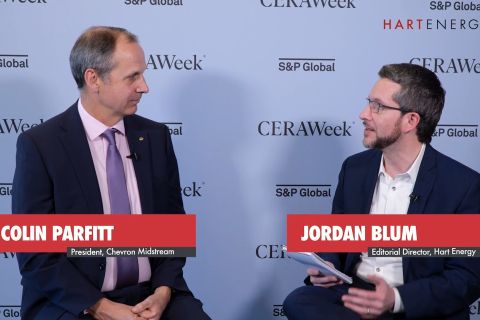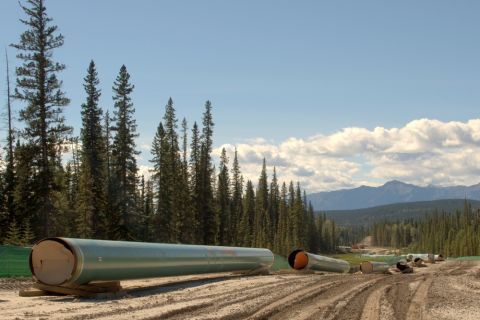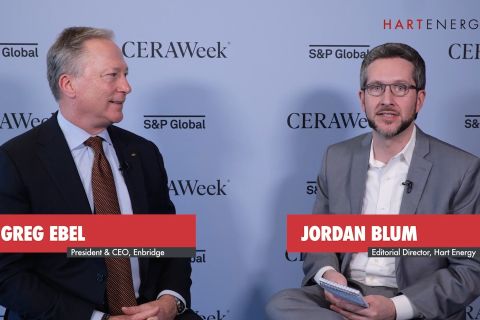It is almost beyond debate that during the past decade, pipeline master limited partnerships (MLPs) have been major contributors to the growth and vibrancy of the midstream space. That growth has been fueled, in part, by the absolute numbers of midstream businesses that have been formed or restructured into MLPs.
And, given recent announcements, more MLPs are on the way. This summer, a number of major energy companies announced plans to separate their upstream, midstream and downstream business lines or drop down assets into new MLPs. Among the most notable companies planning to de-integrate are El Paso Corp., Williams Cos. Inc., ConocoPhillips, Marathon Oil Corp. and SemGroup Corp.
Although the past months have been difficult for stock markets, MLPs have persevered. Recently, the Alerian MLP Index had its greatest rally in its history, rising from a recession low of 152 in November of 2008 up to a high of 390 on April 28, 2011. Volatility continued even at press time, when the index dropped to 316 on August 8, but then soared to 342 on August 10.
Despite the volatility, MLP sponsors perceive that the MLP structure offers a cost of capital advantage over similarly situated public corporations, in part due to the MLP's efficient capital structure that eliminates entity-layer federal income taxes. Investors view the MLP as an opportunity for a superior yield relative to other investment choices, as well as a growth play. Although MLPs have experienced the same ups and downs in the market as similarly situated corporate stocks, more often than not investor interest has remained keen.
Today, potential sponsors and the investing public show more interest than ever in the MLP. As a result, MLP initial public offerings (IPOs) are being hotly pursued by both management and their advisors.
To better understand why the current interest in MLP IPOs is so robust, it is necessary to take a short walk through the evolution of MLPs.
Early history
During most of the presidency of Ronald Reagan, no restrictions existed in the tax laws on the types of businesses that MLPs could conduct and operate. Between the first MLP IPO in 1981 and 1987, there were over 100 MLP IPOs.
Although the MLP space began with its attention directed at oil and gas upstream assets, the focus soon shifted to an assortment of operating business, many of which had no relationship to oil and gas, or even energy. For example, MLPs were formed around motels (La Quinta Motor Inns Limited Partnership/Aircoa Hotel Partners LP), real estate (National Realty LP), amusement parks (Cedar Fair LP), cable television systems (Falcon Cable Systems Co.), and even professional sports (Boston Celtics Limited Partnership).
When Congress saw the proliferation of MLPs in the public markets, it enacted legislation intended to severely restrict the types of businesses that can operate as MLPs. Specifically, Congress sought a means to stem the perceived loss of tax revenue from publicly-traded partnership vehicles, because MLPs, unlike corporations, do not pay federal income taxes.
More specifically, unlike a corporation, which pays taxes on its own income, the income earned by an MLP is passed through to its owners—the public investors. These public investors, in turn, pay the income tax at their individual rates.
Asset types
In 1987, when Congress passed legislation that restricted the use of MLPs, it did not necessarily throw all industries under the proverbial bus. Instead, Congress expressly carved out much of the energy industry from the draconian effects of these new rules, thereby preserving the ability of the energy industry to operate as MLPs.
Under this legislation, for an MLP to be taxed as a flow-through entity, at least 90% of its gross income for each taxable year must be income that is considered to be "qualifying income." If an MLP fails to satisfy this test, the MLP will be taxed as a corporation for federal income tax purposes, thereby eliminating any advantage from operating as an MLP rather than a corporation.
So what is qualifying income? Qualifying income includes, among other things, income and gains derived from the exploration, development, mining or production, processing, refining, transportation (including pipelines transporting gas, oil or products thereof) or the marketing of any mineral or natural resource, as well as certain passive-type income including interest, dividends and real property rents.
For purposes of the qualifying income rule set forth in the tax code, with respect to natural resource-related activities, the term "mineral or natural resource" means fertilizer, geothermal and timber as well as any product from which a deduction is allowable, which includes oil, gas and oil- and gas-related products.
Typically, anything that is dug or pumped out of the ground qualifies, such as coal, lignite, potash, salt, aggregates, limestone, sand and many other hard rock minerals. Moreover, Congress made it clear in the legislation accompanying these qualifying income rules that, for purposes of determining the limits of what constitutes oil, gas, or products thereof, such term includes gasoline, kerosene, number-2 fuel oil, refined lubricating oils, diesel fuel, methane, butane, propane and similar products that are recovered from petroleum refineries or field facilities.
Limitations
Yet, there are limitations. In 1988 Congress clarified the qualifying income rules to provide that certain products, such as soil, sod, turf, water, mosses and minerals from seawater, air and other similar inexhaustible sources are excluded. Thus, items that are renewables, such as agricultural products (wheat or corn, for example), or items that are unlimited in supply, such as solar or wind, do not constitute natural resources for these purposes and, therefore, cannot qualify.
Also, in 2008, Congress amended the MLP tax rules to provide that qualifying income includes the storage and transportation of alternative fuels such as biodiesel and ethanol. However, this amendment does not extend to activities beyond storage and transportation. Therefore, the manufacturing or sale of biodiesel or ethanol does not generate qualifying income.
Moreover, the 2008 amendment provides that any income associated with industrial-source carbon dioxide generates qualifying income, which includes activities such as transportation and marketing.
For purposes of the midstream sector, as long as the MLP is earning income from the transportation of oil, gas or liquids, that income will be qualifying income. In this context, transportation is interpreted widely, but with some parameters.
First, although it appears that any movement of a natural resource or mineral from one place to another will generate qualifying income, Congress seeks to impose limitations on what kinds of transportation would generate qualifying income. In the legislative history to section 7704, Congress indicates that transportation by pipeline of any mineral or natural resource generates qualifying income.
On the other hand, the legislative history states that the transportation of oil and gas, and products of oil and gas, to a retail outlet, other than by pipeline, does not generate qualifying income. As a result, the transportation of oil, gas and products thereof by truck, rail or barge to a retail outlet does not generate qualifying income.
For this purpose, the Internal Revenue Service defines retail to include not only traditional retail customers, but also industrial and commercial users. However, the legislative history makes it clear that the transportation of those items to a bulk distribution center, such as a terminal, or to a utility providing power to customers does generate qualifying income.
Also, the transportation of gas or other products by pipeline to private residences generates qualifying income for local distribution companies. Managing, but not owning, a pipeline that transports a natural resource also generates qualifying income.
As a result of these generally broad rules permitting many types of energy operations to satisfy the qualifying income test, there have been more than 100 energy-related MLPs formed in the past 25 years. The majority of those MLPs focused on energy's midstream sector.
MLP IPOs
During the first two decades of the post-1987 rules for MLPs, one could expect two or three new MLP IPOs per year. During that period, current MLPs such as Ferrellgas Partners LP (1994), Suburban Propane Partners LP (1996) and Enterprise Products Partners LP (1998) were formed.
In 2002, the IPO market for new MLP issuers accelerated with the successful completion of six new MLPs, including Sunoco Logistics Partners LP, MarkWest Energy Partners LP and Natural Resource Partners LP. Other than a blip in 2003 when there was the absence of any new IPOs, that robust level of new issuances continued unabated until the general economic slowdown of 2008 and 2009.
For example, from 2004 through 2008, over 30 energy-related MLP IPOs were completed. During this period, an additional 10 MLP general partners were taken public. The energy-related industries represented in this dash to raise public equity included upstream, midstream (gathering/processing/interstate transportation/storage), shipping, refining and oilfield services (compression). In other words, the entire oil and gas value chain was represented in offerings during this period.
Between mid-2008 and mid-2010, during the recession, the MLP IPO market shut down. Then, in the spring of 2010, the MLP IPO trend rebounded with the IPO of PAA Natural Gas Storage LP, the first for the year. Since then, the market has returned with gusto, evidenced by the successful completion of 12 more MLP IPOs.
Two themes
Two themes have emerged with the recent flurry of MLP IPO activity. First, a wide variety of businesses are going public. Coal operators such as Oxford Resource Partners LP and Rhino Resource Partners LP have taken advantage of the MLP space.
Also, in April 2011, CVR Partners LP completed the first pure fertilizer MLP in almost two decades. And QR Energy LP successfully launched its upstream oil and gas MLP in December 2010, thereby providing some clarity to other companies as to whether the upstream MLP model was one in which investors would participate following the difficulties experienced by many of the upstream MLPs in the recession.
Elsewhere, Golar LNG Partners LP took advantage of the MLP structure to highlight its international shipping fleet in April 2011. Compressco Partners LP, a compression-services provider, launched a relatively small IPO in June 2011, after having been in registration with the Securities and Exchange Commission since before the recession. Finally, a number of midstream companies, in what many consider to be the sweet spot of the MLP market, hit the market with Tesoro Logistics LP leading the way in April 2011.
The second major theme that can be discerned from the recent spate of MLP activities is that investors are seemingly less concerned with the type of asset contained in the MLP than they have been in the past. Now, investors are focused on predictability, stability of cash flow and yield.
In today's interest rate environment, when the 10-year U.S. Treasury is trading at historically low levels, the average yield-seeking institutional investor, and particularly the average individual yield-seeking investor, is hard pressed to find ways to earn yield-based returns substantially in excess of rates a bank will pay for savings accounts. The MLPs are perceived, and rightly so, as an instrument where the investor can earn a strong quarterly yield-based return, and also retain the potential for capital appreciation. Because there are very few other investment opportunities that offer those types of dual-benefits, the MLP sector has seen a tremendous increase in investor appetite for these new IPO issuances.
Even today, there are several new MLPs in SEC registration, including businesses directed at oilfield services, propane, fertilizer and energy upstream and midstream. Other businesses are investigating the space for opportunities to pursue an IPO or sell themselves into an existing MLP.
Tips for success
If a sponsor entity is interested in either converting itself into an MLP or contributing assets to a newly-formed MLP, there are several important features that should be addressed.
First, it is absolutely critical that the financial statements of the company looking to become an MLP are addressed early in the IPO process. Ultimately, the IPO registrant will have to provide, among other things, three years of audited financials. Depending on the factual predicate for the assets that constitute the MLP, this exercise may result in a long lead time for the IPO process, especially when the assets are being carved out of an existing business and have not been the subject of any previous audits.
Also, although it is critical that the business of the MLP qualify under the tax rules described above, it is equally critical that the business is one that is appropriate for an MLP. In other words, the MLP's business should be one that generally entails stable and predictable cash flow, because MLP units are traded on the basis of cash flow and yield rather than net income.
Notwithstanding this general rule, several new MLPs have abandoned the concept of minimum quarterly distributions and have instead embraced the proposition that the operating business is a commodities business that is cyclical in nature. Therefore, the MLP investor should expect greater cash returns when the commodities that are the subject of the MLP are high and diminished cash returns when the commodities are low. This is a major deviation from the historic practice of MLPs, but given its limited use outside the midstream space (primarily for fertilizer MLPs at this point), the overall market impact of this floating distribution structure may be limited.
Another critical piece of the puzzle relates to the use of proceeds of any IPO. That is a shorthand way of referring to the legal and tax planning involved in effectuating an efficient MLP IPO. Many times, it is the use of proceeds of an MLP IPO that determine the tax effect of the public offering. Early planning is critical to allow a sponsor and its legal and tax advisors to prepare a structure that satisfies both the business needs of the new MLP and the efficiency of the IPO from sponsor's standpoint.
Another important timing issue relates to management. The executive management team should be in place at the time the IPO process begins because this team must represent the business during the IPO process and will be the face of the MLP. Often, the new MLP business is only a part of a much larger enterprise. In that case, it is common for the MLP to search for a dedicated chief executive, even if many of the MLP functions are served by existing sponsor employees.
Finally, there is no substitute for preparation and organization in the IPO process. The more upfront work done on the business plan, operations, financial models, tax structuring, accounting and the coordination of the right team of advisors, the more efficient the process will be.
Going forward—and although the macroeconomic signs are uncertain—one should expect continuing and robust activity in the MLP space, absent major constraints in the capital markets. As in most years, that activity will be led by new companies taking advantage of the MLP as a means of operating in a more tax-efficient manner. n
Tim Fenn is a tax partner in the Houston office of Latham & Watkins LLP, has a particular focus in tax issues for partnerships and early-stage structuring, and offers advice on market-related and tax issues. He represents clients, corporations, private-equity firms, investment banks, partnerships and individuals on tax-related issues involving mergers, acquisitions, restructurings and capital transactions.

Recommended Reading
Exclusive: Chevron Balancing Low Carbon Intensity, Global Oil, Gas Needs
2024-03-28 - Colin Parfitt, president of midstream at Chevron, discusses how the company continues to grow its traditional oil and gas business while focusing on growing its new energies production, in this Hart Energy Exclusive interview.
Imperial Expects TMX to Tighten Differentials, Raise Heavy Crude Prices
2024-02-06 - Imperial Oil expects the completion of the Trans Mountain Pipeline expansion to tighten WCS and WTI light and heavy oil differentials and boost its access to more lucrative markets in 2024.
Carlson: $17B Chesapeake, Southwestern Merger Leaves Midstream Hanging
2024-02-09 - East Daley Analytics expects the $17 billion Chesapeake and Southwestern merger to shift the risk and reward outlook for several midstream services providers.
Midstream Builds in a Bearish Market
2024-03-11 - Midstream companies are sticking to long term plans for an expanded customer base, despite low gas prices, high storage levels and an uncertain political LNG future.
Exclusive: Renewables Won't Promise Affordable Security without NatGas
2024-03-25 - Greg Ebel, president and CEO of midstream company Enbridge, says renewables needs backing from natural gas to create a "nice foundation" for affordable and sustainable industrial growth, in this Hart Energy Exclusive interview.





